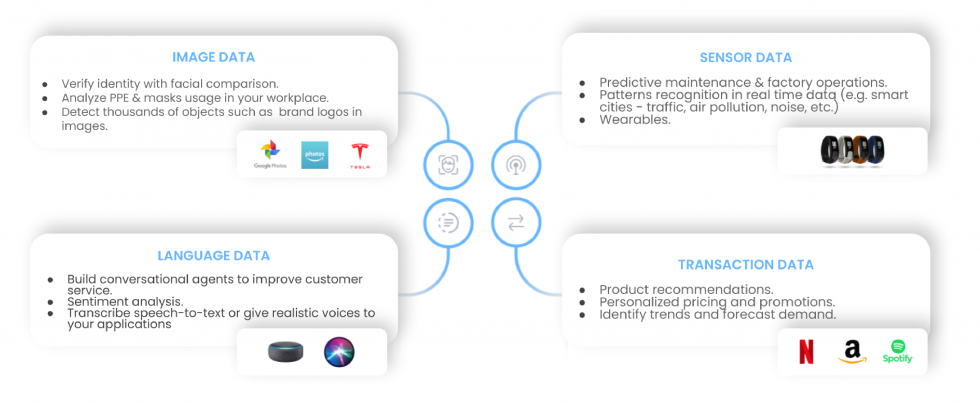
4 types of data to apply Artificial Intelligence
There are 4 types of data for Artificial Intelligence (AI). Understanding them will not only give us an idea of the data necessary for our AI project, but it will also provide us with a very relevant vision of the use cases that we can implement.
The 4 types of data for AI are:
- Image data
- Language data
- Sensor data
- Transaction data

Although humans can see a photo and immediately recognize any object, this process was not easy at all for computers until recently. Traditional computer programming required developers to give computers detailed instructions on exactly what to do in any given situation.
Nowadays, computers can be programmed to learn things from their own experience. This is possible thanks to the advances made in machine learning (ML), as well as to the greater computation and storage capacity of computers that allow data scientists to use approaches such as those used in the human brain itself (neural networks).
Some examples of use cases with image data are:
- Identity verification through facial comparison
- Analysis of the use of PPE and masks in the workplace
- Detection of thousands of objects, such as brand logos
In fact, any of us use these types of algorithms when uploading images to Google Photos or Amazon Photos. Modern cars also use this type of algorithm to detect what happens around them. The latest novelty that has attracted a lot of attention in the field of image AI is DALL-E-2, capable of creating images from a text.
Natural Language Processing (NLP) is a field of AI in which computers analyze, understand and derive the meaning of human language. NLP is another example of a problem that is easy to solve for humans, but very difficult for traditional computing. To understand human language implies not only understanding the words, but also the concepts and how they are linked together to create meaning.
NLP is commonly used for text extraction, machine translation and automated question answering with customer support chatbots. Also, to perform speech-to-text transcription, give realistic voices to applications, or even to perform "sentiment analysis", that is, to know the state of mind of our clients and improve our attention to them.
Nowadays, the proliferation of the Internet of Things (IoT), both at personal and professional levels, means that almost any device that we use in our homes, offices, factories or even on our bodies (wearables) can be online and connected. Cities are sensorized (smart cities) and measure traffic, air quality, noise and all kinds of data that help improve the citizens’ quality of life.
At an enterprise level, IoT has huge implications in how we manufacture goods, provide services, sell to customers and follow up with support. Smart factories and logistics centers are becoming more automated. For example, the application of AI to sensor data enables predictive maintenance, that is, predicting where failures will occur before they occur in order to more efficiently replace and repair faulty equipment, and even assign tasks to our operators facilitating decision-making at certain moments of the operational chain.
Transaction data are the recorded information of the transactions performed by users. A transaction is a sequence of information exchange that satisfies a request, for example, a purchase in an e-commerce or a viewing on a streaming platform.
Our credit cards data are transactional data. Hence, an important field for AI based on transactional data is fraud detection and analysis of payment transactions. Also, through the application of AI in this type of data, we can perform sales forecasts in stores and predictions of stock breakages in warehouses. Other common use cases are personalized recommendations to our users (such as the ones made for us by Amazon, YouTube, Netflix or Spotify), as well as customized promotions and cross-selling.
We have seen the different types of data for AI. Starting by understanding the data is a very useful way to glimpse the type of applications that AI offers.
If you want to move forward, we suggest you to read "The necessary team for your Artificial Intelligence project"… and, if you need help in adopting AI and Machine Learning, contact us!










